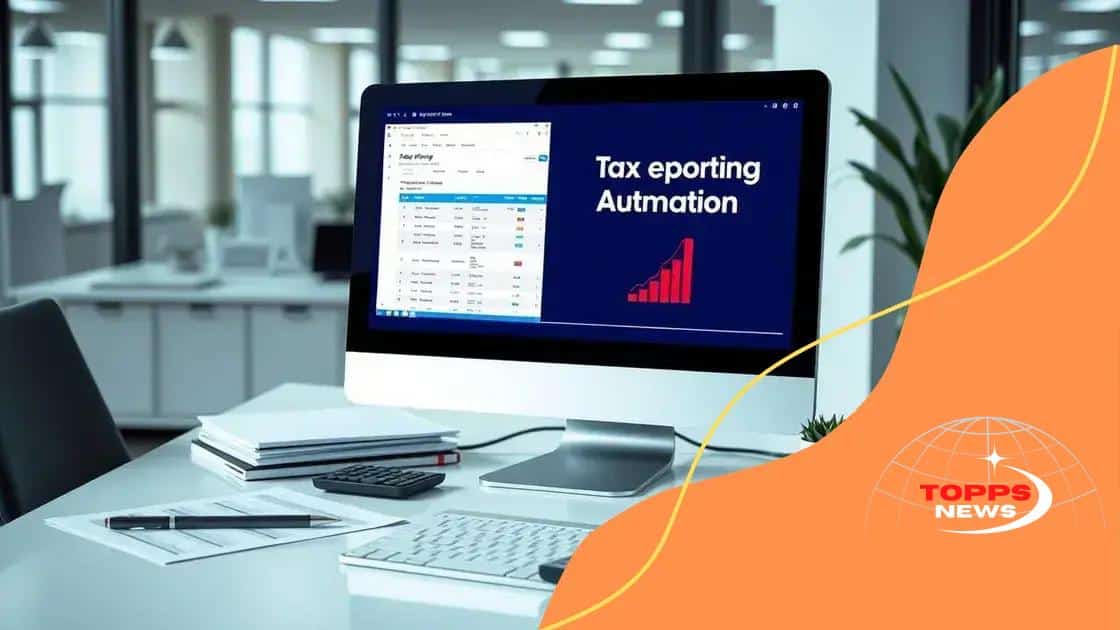Tax reporting automation tools that simplify your life

Tax reporting automation tools streamline financial processes by enhancing accuracy, improving efficiency, and ensuring compliance with current regulations, making them essential for modern businesses.
Tax reporting automation tools are becoming essential for businesses looking to streamline their financial processes. Have you ever wondered how these tools can save you time and reduce stress? In this article, we’ll explore their benefits and best practices.
Understanding tax reporting automation tools
Understanding tax reporting automation tools is essential for any business wanting to streamline its financial processes. These tools make tax reporting less daunting and allow for more accurate records.
Automation simplifies numerous aspects of tax reporting. It helps in gathering necessary data, calculating taxes owed, and submitting forms accurately and on time. This means you can spend less time on paperwork and more time on your business.
How do these tools work?
Tax reporting automation tools leverage software to handle complex calculations that come with tax regulations. These innovations facilitate:
- Data integration from various financial platforms.
- Accuracy in computations to minimize errors.
- Timely updates on tax regulations.
- Generating reports that are easy to understand.
By understanding how these tools function, businesses can choose solutions that fit their specific needs. Additionally, automation can adapt to different accounting software, providing flexibility.
Benefits of using automation
Utilizing tax reporting automation tools yields significant advantages. First, consider the time savings; automated systems can dramatically reduce the hours spent on tax preparation. Secondly, accuracy is improved, as calculations are performed by software designed to follow current laws.
Moreover, automation minimizes human error. Mistakes can lead to fines or misrepresentation of a company’s financial status. Tools that offer real-time updates ensure that all changes in tax laws are accounted for, giving businesses peace of mind.
Lastly, automation frees up valuable resources. By reducing time spent on manual processes, teams can focus on strategic initiatives or customer-related tasks. Overall, tax reporting automation tools are not just about efficiency; they promote growth and stability in your organization.
Key benefits of automation for tax reporting
Key benefits of automation for tax reporting are essential to understand for any organization looking to enhance its financial processes. Automating tax reporting can lead to significant improvements in accuracy, efficiency, and compliance.
One major benefit is the reduction of human error. When tax reporting is automated, calculations are performed by software designed to adhere to current tax laws, decreasing the chances of mistakes that could lead to penalties.
Improved efficiency
Automation streamlines the entire tax reporting process. By integrating data from various sources, businesses can compile necessary information quickly. This allows teams to focus on strategic decision-making rather than getting bogged down by paperwork.
- Faster data collection and processing.
- Reduced time spent on manual entries.
- Immediate access to financial records.
- Ability to generate reports in real time.
Moreover, automated tools can help companies keep track of important deadlines. By setting up reminders, businesses ensure they never miss crucial filing dates. Additionally, the resources saved by using these tools can be redirected to other important tasks, enhancing overall productivity.
Cost savings
While there may be an initial investment in automation software, the long-term cost savings can be substantial. By cutting down on manual labor, businesses can reduce staffing costs associated with tax preparation. Furthermore, accurate tax reporting minimizes risks of fines and penalties due to errors or delayed submissions.
Ultimately, the enhanced visibility into a company’s financial situation afforded by automation can lead to better financial planning. This means companies can allocate funds more efficiently, invest in growth opportunities, and respond more effectively to market changes. Overall, automation transforms tax reporting from a daunting task into a seamless part of financial management.
How to choose the right tools for your needs

How to choose the right tools for your needs is crucial for businesses looking to streamline their tax reporting processes. With many options available, it’s important to select tools that best fit your specific requirements.
Start by assessing your business needs. Consider factors like the complexity of your financial situation, the size of your team, and your budget. Understanding your unique circumstances will help you find tools tailored to your situation.
Key features to look for
When evaluating tax reporting automation tools, keep an eye on the following features:
- User-friendly interface for easy navigation.
- Real-time data integration from various sources.
- Scalability to grow with your business.
- Customer support options for assistance when needed.
Moreover, think about the software’s compatibility with your existing systems. Tools that easily integrate with your current accounting platforms will save time and reduce errors. Don’t forget to look into the security measures in place. Protecting your financial data is paramount.
Trial and feedback
Many automation tools offer trial periods. Take advantage of these to test functionality before committing. Gather feedback from your team to see how well the tool meets their needs. Their practical experience will provide insights into whether a particular option is truly beneficial.
Lastly, consider reviews and ratings from other users. Researching how a tool has performed for similar businesses can offer valuable guidance. By weighing these factors, you can make an informed decision and choose tools that enhance your tax reporting process.
Best practices for implementing automation
Best practices for implementing automation in tax reporting can make a significant difference in how efficiently your business operates. Following certain strategies ensures successful integration of these tools into your existing processes.
First, engage your team early in the process. Their feedback is invaluable. Involving them helps identify specific pain points and features that would be most beneficial. Their involvement also fosters a sense of ownership and eases the transition to automated systems.
Create a clear roadmap
Having a structured plan is essential. Outline the steps for implementation and set measurable goals. This roadmap should include timelines and specific objectives to keep everyone on track. Regular check-ins will help assess progress and allows for adjustments along the way.
- Identify necessary tools and software.
- Set deadlines for each phase of implementation.
- Regularly review the progress and adapt the plan as needed.
- Train your staff to ensure they are comfortable and knowledgeable about the new processes.
As you implement automation, prioritize data security. Ensure the tools you choose comply with industry security standards. This protects sensitive financial information and builds trust with your clients.
Monitoring and evaluation
After implementing automation, monitoring performance is crucial. This allows you to evaluate whether the tools are achieving the desired results. Gather data on efficiency, accuracy, and user satisfaction. Utilize this data to refine your automation strategy over time.
Remember that automation is not a one-time process; it requires continuous assessment and improvement. By keeping these best practices in mind, you can create a smooth transition to automated tax reporting that enhances productivity and financial accuracy.
Future trends in tax reporting automation
Future trends in tax reporting automation are shaping the way businesses handle their financial processes. As technology evolves, several key trends are emerging that can significantly impact tax reporting.
One major trend is the rise of artificial intelligence (AI) in automation. AI will enhance data analysis capabilities, allowing for more accurate predictions and insights. This shift means that businesses will be able to anticipate changes in tax regulations and prepare for them adequately.
Enhancements in data analytics
As automation tools become more sophisticated, data analytics will be a significant focus. Companies will leverage advanced analytics to uncover patterns in their financial data. This will lead to better decision-making and optimized tax strategies. Here are some key points to consider:
- Increased use of machine learning to analyze financial trends.
- Enhanced ability to forecast tax liabilities based on real-time data.
- Automated reporting that provides deeper insights into financial health.
- Integration of big data technology to improve accuracy and efficiency.
Another trend is the increased emphasis on compliance. As tax laws continue to evolve, automation tools will incorporate compliance checks. This ensures that businesses remain in line with current regulations and avoid costly penalties. With real-time updates, businesses can adapt their reporting practices quickly and efficiently.
Cloud-based solutions
Cloud technology is likely to play a crucial role in the future of tax reporting. Cloud-based solutions offer flexibility and accessibility, enabling teams to access necessary information from anywhere. This trend supports remote work and collaboration among teams. Additionally, cloud computing enhances data security, as service providers often employ rigorous security measures.
Lastly, the focus on user-friendly interfaces will grow. As businesses adopt new tools, there will be a demand for software that is easy to navigate. Intuitive designs will help employees adapt quickly, creating a smoother transition to automation.
FAQ – Frequently Asked Questions about Tax Reporting Automation
What are the main benefits of tax reporting automation?
Tax reporting automation offers improved accuracy, reduces errors, and saves time by streamlining the entire reporting process.
How can AI enhance tax reporting?
AI can analyze data more efficiently, helping to predict tax liabilities and ensuring compliance with current tax regulations.
What should I consider when choosing automation tools?
Consider factors like user-friendliness, integration with existing systems, security features, and the level of customer support provided.
How does cloud technology contribute to tax reporting?
Cloud technology allows for flexible access to financial data, improves collaboration, and enhances data security for remote work.





